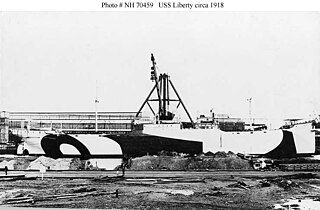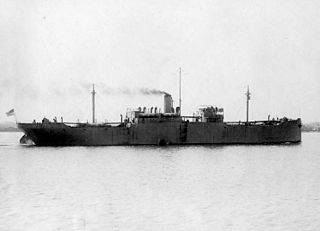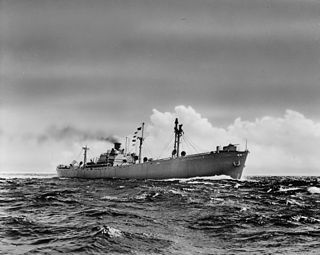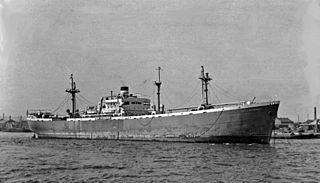
Liberty ships were a class of cargo ship built in the United States during World War II under the Emergency Shipbuilding Program. Although British in concept, the design was adopted by the United States for its simple, low-cost construction. Mass-produced on an unprecedented scale, the Liberty ship came to symbolize U.S. wartime industrial output.

Hog Islanders is the slang for ships built to Emergency Fleet Corporation designs number 1022 and 1024. These vessels were cargo and troop transport ships, respectively, built under government direction and subsidy to address a shortage of ships in the United States Merchant Marine during World War I. American International Shipbuilding, subsidized by the United States Shipping Board, built an emergency shipyard on Hog Island at the site of the present-day Philadelphia International Airport.

Eurana was a steam cargo ship built on speculation in 1915 by Union Iron Works of San Francisco. While under construction, the ship was acquired by Frank Duncan McPherson Strachan to operate in the Atlantic trade for his family's Strachan Shipping Company. The vessel made several trips between the Southeast of the United States and Europe before being sold to the Nafra Steamship Company in 1917. The freighter then entered the Mediterranean trade where she remained until September 1918 when she was requisitioned by the Emergency Fleet Corporation and transferred to the United States Navy to transport military supplies prior to the end of World War I, and as a troop transport after the war's end. In October 1919, the ship was returned to Nafra, which was then being reorganized to become the Green Star Steamship Company. In 1923, Eurana and twelve other ships passed to the Planet Steamship Company, newly formed to receive them from Green Star's bankruptcy. The ship remained principally engaged in the West Coast to East Coast trade for the next seven years. In 1930, together with several other vessels, Eurana was purchased by the Calmar Steamship Corporation, and renamed Alamar. The ship continued carrying various cargo between the East and West Coasts of the United States through 1941. On 27 May 1942, while en route from Hvalfjord to Murmansk carrying lend-lease war materiel to the Soviet Union during World War II as part of Arctic convoy PQ-16, she was fatally damaged by German aircraft bombs and was consequently scuttled by a British submarine to prevent her from becoming a menace to navigation.

USS Refuge (AH-11), was a hospital ship of the United States Navy during World War II. The ship was built in 1921 by the New York Shipbuilding Corp., of Camden, New Jersey, as SS Blue Hen State, but was renamed President Garfield in 1923 and then SS President Madison in 1940 for service with American President Lines. Acquired by the Navy from the War Shipping Administration on 11 April 1942 the ship was commissioned as the transport USS Kenmore until conversion to a hospital ship.
SS George Calvert was a Liberty ship built in the United States during World War II. She was named after George Calvert, an English politician and colonizer. Calvert took an interest in the British colonization of the Americas, becoming the proprietor of the Province of Avalon, the first sustained English settlement on the southeastern peninsula on the island of Newfoundland. He later sought a new royal charter to settle the region, which would become the state of Maryland.

USS Aeolus (ID-3005), sometimes also spelled Æolus, was a United States Navy troopship in World War I. She was formerly the North German Lloyd liner Grosser Kurfürst, also spelled Großer Kurfürst, launched in 1899 that sailed regularly between Bremen and New York. At the outset of World War I the ship was interned by the United States and, when the US entered the war in 1917, was seized and converted to a troop transport.

USAT Liberty was a United States Army cargo ship torpedoed by I-66 in January 1942 and beached on the island of Bali, Indonesia. She had been built as a Design 1037 ship for the United States Shipping Board in World War I and had served in the United States Navy in that war as animal transport USS Liberty (ID-3461). She was also notable as the first ship constructed at Federal Shipbuilding, Kearny, New Jersey. In 1963 a volcanic eruption moved the ship off the beach, and Liberty's wreck is now a popular dive site.

SS Empire Simba was a British steam-powered cargo ship. She was originally an American ship, launched in 1918 as SS West Cohas. During a stint in the United States Navy from 1918 to 1919, she was called USS West Cohas (ID-3253).

Wakulla was a steam cargo ship built in 1918-1919 by Los Angeles Shipbuilding & Dry Dock Company of San Pedro for the United States Shipping Board as part of the wartime shipbuilding program of the Emergency Fleet Corporation (EFC) to restore the nation's Merchant Marine.

SS West Loquassuck was a steel–hulled cargo ship built for the United States Shipping Board's Emergency Fleet Corporation in World War I. After completion on 15 October 1918, the ship was immediately commissioned into the U.S. Navy as USS West Loquassuck (ID-3638), just weeks before the end of the war.

SS Arthur M. Huddell is a Liberty ship built in the United States during World War II and is now a museum ship, SS Hellas Liberty, in Greece.

SS Vesta was a propeller-driven fishing vessel 250 gross tons, built in 1853 at Nantes, France, by Hernoux et Cie of Dieppe for the Société Terreneuvienne of Granville in Normandy. The company had extensive fishing interests in the Grand Banks area off Newfoundland, which it operated from a base in Saint Pierre Island. On 27 September 1854 Vesta was eastbound with a crew of 50, returning 147 fisherman and salters home. In a heavy fog, Vesta collided with the Collins Line passenger paddle steamer SS Arctic. A three-metre (ten-foot) section of Vesta's bow was sheared off, but the watertight bulkhead behind the bow remained intact and kept out the sea, keeping the vessel afloat.

SS Mary Luckenbach, was a cargo ship of the United States Navy. She was launched in 1918 and completed the following year by the American International Shipbuilding Corp., Hog Island, Pennsylvania as USS Sac City (ID-3861).
Ruth Kellogg was a 5,037 GRT tanker that was built in 1920 as the Design 1025 Hog Islander Calaumet by American International Shipbuilding, Hog Island, Philadelphia, Pennsylvania, United States for the United States Shipping Board (USSB). Completed as Vaba, she was converted to a tanker in 1921. A sale in 1929 saw her renamed Ruth Kellogg. In 1940, she was transferred to the British Ministry of War Transport (MoWT). Renamed Empire Dolphin in 1941, she served until 1947 when she was scrapped.

Corvus was a steam cargo ship built in 1919 by Columbia River Shipbuilding Company of Portland for the United States Shipping Board as part of the wartime shipbuilding program of the Emergency Fleet Corporation (EFC) to restore the nation's Merchant Marine. The freighter was operated on international and domestic routes through 1944. Early in 1945 she was transferred to Soviet Union as part of lend-lease program and renamed Uzbekistan. After several months of operation, the freighter was rammed by another vessel on 31 May 1945 and was beached to avoid sinking. She was subsequently raised and towed to Portland where she was scrapped in 1946.
SS Christopher Newport was a Liberty ship built in the United States during World War II. She was named after Christopher Newport, who was an English seaman and privateer. He is best known as the captain of Susan Constant, the largest of three ships which carried settlers for the Virginia Company, in 1607, on the way to found the settlement at Jamestown, in the Virginia Colony, which became the first permanent English settlement in North America. He was also in overall command of the other two ships on that initial voyage, in order of their size, Godspeed and Discovery.

SS Anne Hutchinson was a Liberty ship built by the Oregon Shipbuilding Company of Portland, Oregon, and launched on 31 May 1942 The ship was named after the Anne Hutchinson, a 1600 Massachusetts Bay Colony Puritan.
Rock Island Bridge was a steam cargo ship built in 1919 by Submarine Boat Company of Newark for the United States Shipping Board (USSB) as part of the wartime shipbuilding program of the Emergency Fleet Corporation (EFC) to restore the nation's Merchant Marine. In March 1920 while on her maiden voyage the vessel collided with another steamer and subsequently had to be beached to avoid sinking. She was later abandoned and sold for scrap.

SS Ben H. Miller was a British merchant ship of World War II. A Liberty ship built in the United States in 1943, she was bareboat chartered to the British Ministry of War Transport, with Ellerman and Papayanni as managers. Sold to her managers after the war, she was renamed SS City of Shrewsbury in 1947. Resold in 1959, she became the Compagnia de Navigazione Arcoul's SS Marucla, and was scrapped in 1969. Her original namesake was Ben H. Miller.
American Foreign Steamship Corporation was founded in Brooklyn, New York City, in 1932 by Ira L. Rosenson, Sophia Pruss and Elias Katz. Rosenson was an attorney and the major shareholder in the firm. American Foreign Steamship Corporation purchased a 5,570-ton cargo ship SS Eastern Glen from the American South African Line in 1933. American Foreign Steamship Corporation named the ship the SS American Oriole. The ship was built by Kabushiki Kaisha Uchida Zosengo company of Yokohama, Japan, in 1920. The ship was a United States Shipping Board ship. The next two ships purchased was the SS Liberty Glo and SS Wildwood, these were Hog Islanders type ships. The two ships were purchased from the South Atlantic Steamship Company. In 1938 another Hog Islanders ship was purchased the, SS Magmeric, renamed the SS American Robin. The American Oriole was sold to England in 1940 to help with the World War II efforts. She was renamed the SS Barberrys, but on November 26, 1942, she was sunk by a torpedoed from German submarine U-663 off of St. John's, Newfoundland.















